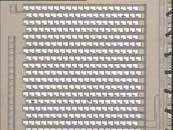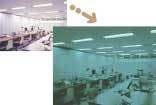Newsbreaks
Multiwavelength femtosecond pulses are phase-coherent
Phase-coherent multiwavelength femtosecond pulse trains have been generated by scientists at the National Institute of Advanced Industrial Science and Technology (Tsukuba, Japan), who optically phase-locked the pump and subharmonic signal and idler pulses in an optical parametric oscillator pumped with a Ti:sapphire laser. Such pulses could be useful in attosecond pulse generation or quantum control of chemical reactions. Confirming phase coherence, the researchers observed clear interferometric fringes between two sum-frequency pulses.
Defining the pump as having an optical frequency of 3ω, the frequencies of the signal and idler were 2ω and ω. Doubled signals and sum-frequency generation produced harmonics up to 6ω, with six wavelengths in all—425, 510, 638, 850, 1275, and 2550 nm. The beat between a (3ω + ω) and a (2ω + 2ω) signal was used for phase locking. Converted to voltage, the beat signal was damped to a few hundred kilohertz when the voltage drove a piezoelectric transducer that changed the laser's cavity length. Oscilloscope Lissajous curves of the beat and reference signal produced a circle that was stable for more than 1 h and showed phase stability of 0.1 rad. Contact Yohei Kobayashi at [email protected].
Imaging interferometric microscope has large depth of focus
By combining a low-numerical-aperture (low-NA) microscope objective with off-axis coherent illumination and injection of a far-off-axis zero-order beam, researchers at the University of New Mexico (Albuquerque, NM) have created a 200× imaging interferometric microscope that has the resolution of a high-NA system and the large focal depth and field of a low-NA system. A theoretical Fourier-optics model of the microscope agrees with experimental results.
An off-axis 633-nm coherent beam that does not pass through the objective irradiates a binary mask that has dense 0.5-µm features; the 0.4-NA objective captures only higher orders. A second beam mimicking the lost zero-order beam is introduced below the objective. A second similar setup exists for the orthogonal lateral direction. A brightfield image is taken, then a darkfield image (blocking the reference beam), and then a low-frequency image (moving the mask to a spot without features). The sets of data are then electronically combined to reconstruct an image. Comparison to white-light images taken through a 0.9-NA objective shows higher quality in some respects (such as contrast at high frequencies) for the interferometric image. Contact Steven Brueck at [email protected].
Edge-detecting silicon retina chip has optical output
Detection of object edges in images is important in vision-systems applications ranging from semiconductor lithography to industrial mass-production. Low-level feature-extraction methods with optical outputs can serve to extend the optical portion of the image processing, reserving electronic calculation for extraction of more-sophisticated information. Researchers at The University at Buffalo (Buffalo, NY) and Stanford University (Palo Alto, CA) have developed an edge-detecting "silicon retina" chip with an optical output, although with on-chip analog electronic intermediate processing.
A 19 × 19-pixel array of silicon detectors covers a 2 × 2-mm chip, forming a Mahowald-Mead retina with hexagonally connected resistors that diffuse the input signals. Each pixel also contains a ferroelectric liquid-crystal (FLC) spatial-light modulator. Clocked sampling of the resistive network results in difference-of-Gaussians outputs, which drive the FLC modulators. Each cell uses 100 µW of power at switching speeds of a few kilohertz. In one experiment, a red-emitting laser provided an input signal; illumination by a blue light-emitting diode modulated by the device became the output signal, which highlighted edges. Fabricated with CMOS technology, the retina chip could be scaled up in size without much difficulty. Contact Albert Titus at [email protected].
Finite-impulse-response filter separates color simply
Researchers at Zhejiang University (Hangzhou, China) and Hong Kong University of Science and Technology have developed a design method for a type of optical filter called a finite-impulse-response filter. Based on birefringence, the filter is composed of a series of crystal retarders between polarizers, with the optical axis of each retarder parallel to its surface but rotated at a specific angle relative to the other crystals. The so-called optical-backward-transfer design method is based on numerical-approximation algorithms (Chebyshev and least-square).
A green/magenta filter, which passes green light and reflects red and blue, was fabricated for use with a liquid-crystal-on-silicon display. The filter has nine layers of quartz, each with a phase delay of 10.755 µm. The spectral curve of the filter, which was designed for collimated light, shows a sharp cut-on and cut-off at 0° incidence angle. A spectral shift, slight reduction in transmission, and increased side lobes occur for angles increasing to 30°. Theory shows that the increased side lobes are a result of fabrication errors. The simplicity of the filter and its large angular range makes it attractive for color separation and combination. Contact Feihong Yu at [email protected].
Nitrogen implantation boosts gallium arsenide MSM detector performance
Implanting high-energy nitrogen ions in gallium arsenide (GaAs) has allowed scientists at the Research Centre Jülich (Jülich, Germany), the Slovak University of Technology (Bratislava, Slovakia), and the University of Rochester (Rochester, NY) to fabricate high-speed metal-semiconductor-metal detectors that have a dark current close to two orders of magnitude lower than their nonimplanted counterparts. In addition, the responsivity more than doubles.
Nitrogen ions of 700 and 880 keV, respectively, were implanted in two sets of detectors, and a set of control detectors were made without implantation on more-expensive low-temperature-grown GaAs. Titanium/gold fingers 1 µm wide were fabricated on the GaAs. An 880-keV-implanted detector had a dark current of 10 nV at a bias of 1 V and a responsivity of 20 mA/W at a 20-V bias. A commercial Ti:sapphire laser producing 100-fs pulses at an 810-nm wavelength and 82-MHz repetition rate was used to test the detector's time response. Both implanted and nonimplanted detectors showed a 2.5-ps photoresponse time; the 880-kV-implanted detector had the highest response amplitude of 2 V. Larger ion doses will further improve performance, say the researchers. Contact Martin Mikulics at [email protected].
Strontium aluminate turns fluorescent bulb into emergency light
Emergency lighting for public and commercial buildings usually comes in the form of spotlight and battery-box units mounted here and there on the wall. These fixtures require their own wiring and must thickly populate a building for adequate coverage. Engineers at American Environmental Products (Fort Collins, CO) have developed an alternative—a fluorescent bulb that glows even after electricity is switched off or fails.
Along with a conventional full-spectrum fluorescent phosphor, the bulb's inner surface contains strontium aluminate (SrAl2O4), which, along with the fluorescent phosphor, is pumped by the bulb's ultraviolet-emitting mercury arc (15 min is required for a full charge). When electricity is lost, the SrAl2O4 emits light with a 490-nm spectral peak at an initial output in lumens of 20% of the bulb's powered output. For about an hour, the unpowered output remains bright enough to allow for emergency activities such as exiting the building. Because no electricity is involved, bulbs can be removed from their fixtures and used as flashlights; even when the bulb is broken, its shards can be used for illumination. (The bulb may not find much use in movie theaters.) Contact Moby Wile at [email protected].


